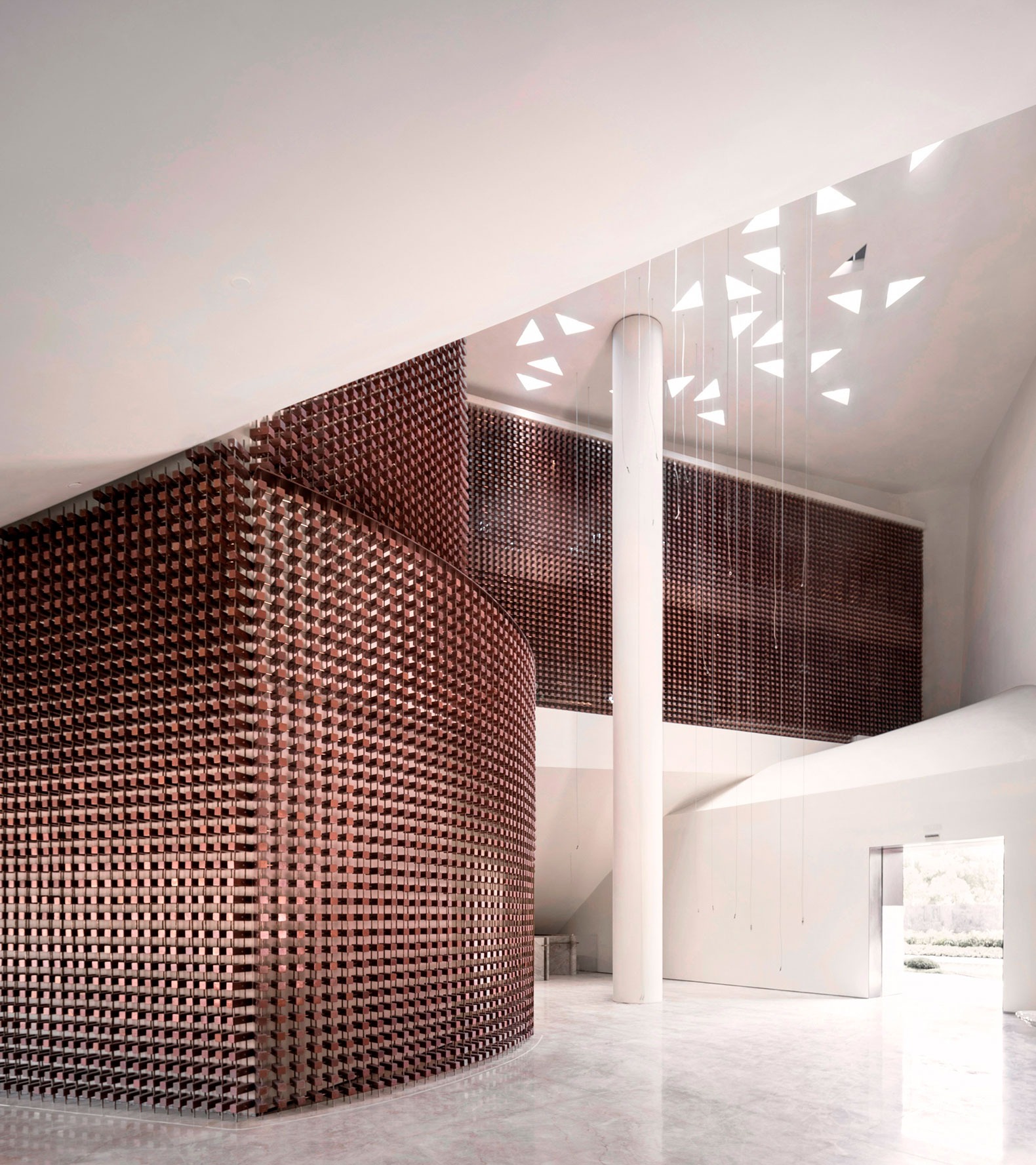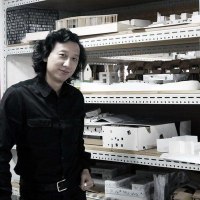
The project developed by AZL architects arranges the interior around an exhibition hall on the ground floor and around a library on the second floor, connecting the art space with a large underground community hall. The art pavilion intends to create a space to put culture and create a sense of community belonging to the place's history.
The building features an interesting and complex curved surface made as a curtain wall with bricks that establish a dialogue with the history of the existing city wall of Nanjing. Through an intentional play of colours, the glazed bricks of the façade pay homage to the traces of time reflected in the wear and tear of the bricks of the city wall.

Jinling Diamond Art Pavilion by AZL architects. Photograph by Hou Bowen.
Project description by AZL architects
In October 2023, azLa received a challenging design invitation themed “The Renaissance of Jinling under Sycamore Tree” to design a small art pavilion, reflecting Nanjing’s rich urban heritage and construction traditions. Nanjing, formerly known as Jinling, has a city-building history of nearly 3,100 years and a capital history of 1,800 years, making it a significant birthplace of Chinese civilization. During the Six Dynasties period, Nanjing was the largest city in the world and the first city with a population exceeding one million, representing classical Chinese culture.
In ancient texts, “陵” (ling) means a person standing on land with yin and yang energies intertwined, and grass growing on top symbolizes vitality. In oracle bone and bronze inscriptions, “陵” and “菱” (ling) both symbolize the upward-growing spirit.
Nanjing is also known as the Stone City. Starting in 1366, Zhu Yuanzhang, Taizu of Ming, began constructing four concentric city walls: the Palace City, Imperial City, Capital City, and Outer Wall. The outer contours were built using natural ridges, roughly forming a diamond shape. The Qinhuai River is Nanjing’s mother river, and the No. 61 He Fang, built by the Tao family in the late Qing Dynasty, is considered the best-preserved and most culturally valuable river house in Nanjing. This river house is diamond-shaped, with both the building’s structure and its flagstones and wooden components all in diamond shapes.

The project site is located in the center of a residential area, with the site forming an approximately 20-degree angle with the east street. The design’s base part is parallel to the high-rise residential buildings on the north and south sides, with the top gently twisted so that the upper shape aligns nearly parallel with the road. The twisting of the Jinling Diamond Art Pavilion differs from conventional single-direction rotations; it is intended to represent the upward-growing spirit of the character “陵” standing on the earth. The twisted diamond shape and rectangular base create rich interior and exterior spaces, with the curves and intersections of shapes presenting challenges in materials and construction.
The design uses 139,000 pieces of 60x60x180mm ceramic bricks for the facade, paying homage to Nanjing’s existing city wall’s scale and history. The ceramic bricks’ color references a late Eastern Jin Dynasty city brick in the Nanjing Museum inscribed with the word “Stone.” Although all customized ceramic bricks have the same size specifications, they come in glazed and unglazed textures.

The ceramic brick curtain wall employs two fixing methods: “prefabricated U-shaped slots with through bolts” for the curved surface at the main entrance, and conventional “prefabricated chemical anchors” for other facades and roofs. In addition to the construction of the double-curved surface, the design addresses over a dozen types of junctions, including two-face, three-face, and five-face junctions.
The curtain wall units are linear, approximately 1.2 meters long, with each ceramic brick’s angle adjustable via back bolts. When arranging units on a curved surface, the curve is unfolded and rationally divided into straight units while considering the density of surface intersections. The arrangement of units on the straight face differs from the curved face, requiring diagonal lines on the curve to transition smoothly to the straight face. For intersections with steep angles, units may be rotated 90 degrees locally to ensure uniformity. The complexity and accuracy of constructing three-dimensional curves and surface intersections were validated with a 1:1 physical model on site.

The glazed and UN-glazed ceramic bricks, with fewer than a third being glazed, are arranged in a gradient pattern from top to bottom, honoring the time-worn traces of the Nanjing city wall.
The vision of this small art pavilion is to showcase community belonging and cultural cohesion. It includes a ground-level exhibition hall and a second-floor library, with a staircase connecting the art space to a large-scale underground community hall, providing comprehensive services to the community.
No other city, after experiencing a millennium of glory and disgrace, remains so tranquil. The inclusive and open spirit nurtured through cultural iterations is Nanjing’s enduring “base color.” The Jinling Diamond Art Pavilion embodies Nanjing’s steady yet flexible urban character through its twisting form, vividly reflecting the city’s essence of stability and adaptability.




















































